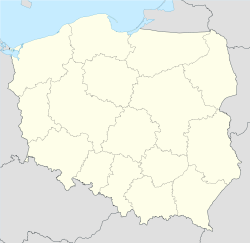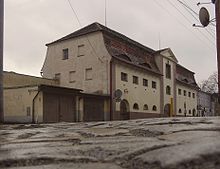- Nowa Sól
-
Nowa Sól Museum 
Flag
Coat of armsCoordinates: 51°48′N 15°43′E / 51.8°N 15.717°E Country  Poland
PolandVoivodeship Lubusz County Nowa Sól County Gmina Nowa Sól (urban gmina) Government - Mayor Wadim Tyszkiewicz Area - Total 21.56 km2 (8.3 sq mi) Population (2006) - Total 40,351 - Density 1,871.6/km2 (4,847.3/sq mi) Time zone CET (UTC+1) - Summer (DST) CEST (UTC+2) Postal code 67-100 to 67-103 Car plates FNW Website http://www.nowasol.pl Nowa Sól [ˈnɔva ˈsul] (German: Neusalz an der Oder) is a town on the Oder River in Lubusz Voivodeship, western Poland. It is the capital of Nowa Sól County and had a population of 40,351 as of 2006.
Contents
History
The first settlement in the region of modern Nowa Sól dates to the 14th century, when the territory was under Bohemian sovereignty. In order to break Silesia's dependency on salt from Poland, Emperor Ferdinand I founded the demesne land Zum Neuen Saltze in 1563.[1] The sea salt, originally from La Rochelle and the Iberian coast, was transported from Hamburg and Stettin (Szczecin) along the navigable Oder. A flood in 1573 led to the relocation of the salt refinery to the nearby village of Modritz (Modrzyca); the office of the administrator is now the town hall. The settlement was documented as Neusalzburg ("New Salzburg") in 1585 and later as Neusalz ("New Salt"). A trading harbor was built on the Oder in 1592. The Protestant Church of St. Michael, built from 1591–97, was converted to Roman Catholicism in 1654.[2]
The entrance of Dutch and English merchants in the Baltic Sea at the end of the 16th century led to difficulties in the supply of unrefined salt.[1] The unprofitable enterprise was also hampered by tolls on the Oder imposed by the Margraviate of Brandenburg.[1] Salt refining in Neusalz nearly collapsed during the Thirty Years' War (1618–48), while recovery was hampered by the salt trade of Brandenburg and Poland afterwards.[1] As the rulers of Swedish Pomerania, Sweden prevented salt from reaching the town from Stettin in 1710. Three years later Neusalz became an outpost for salt from Magdeburg and Halle.[1]
Neusalz developed into one of the largest ports on the Silesian Oder and handled the majority of salt traffic on the river.[1] It was annexed by the Kingdom of Prussia in 1742 according to the Treaty of Breslau. When King Frederick II of Prussia granted Neusalz town rights on 9 October 1743 and initiated plans to expand the town,[1] it had 97 houses.[2] A colony of the Moravian Church was also founded in the same year. After the Battle of Kunersdorf, Neusalz was plundered on 24 September 1759.[2] Forty houses were burnt down, as was the Moravian community, which was restored in 1763.
Neusalz was administered within Landkreis Freystadt i. Niederschles. in Prussian Silesia after the Napoleonic Wars. The modern industrial development began in the 19th century when new factories, especially linen factories and steelworks, were opened. Neusalz was first connected to the Silesian railway in 1871, the same year the town became part of the German Empire during the unification of Germany. Expansion and modernization of the harbor began on 11 October 1897. Neusalz became part of the Prussian Province of Lower Silesia in 1919. A wooden bridge across the Oder, originally built in 1870, was rebuilt using reinforced concrete in 1932.[2]
During World War II Neusalz was the site of a labor camp belonging to the Gross-Rosen concentration camp. German troops destroyed the concrete bridge on 9 February 1945, but the Soviet Red Army entered Neusalz on 13/14 February 1945.[2] A number of buildings burnt down, including the Catholic Church.[2] The town was placed under Polish administration according to the post-war Potsdam Conference and renamed Nowa Sól. Germans remaining in the town were expelled and replaced with Poles.
Nowa Sól was rebuilt as an industrial and administrative center, superseding nearby Kożuchów. From 1975–98 it was in the Zielona Gora Voivodeship, after which it became part of the Lubusz Voivodeship. The town is featured in the documentary 5000 Miles, about a family from Wisconsin in the United States wishing to adopt a Polish child.
People
- Christian David Gebauer (1777–1831), painter
- Gustav A. Schneebeli (1853–1923), politician
- Otto Jaekel (1863–1929), paleontologist
- Alfred Saalwächter (1883–1945), General Admiral
- Seweryn Krajewski (born 1947), musician
- Janusz Liberkowski (born 1953), winner of the first season of American Inventor
- Józef Młynarczyk (born 1953), retired player for the Poland national football team
- Bogdan Bojko (born 1959), politician
Population
- 1743: 800[3]
- 1787: 1,503
- 1825: 2,211
- 1868: 5,109
- 1890: 9,075
- 1905: 13,002
- 1929: 14,300 to 16,300 (agglomeration)
- 1939: 17,326
- 1961: 27,425
- 1970: 33,386
See also
- 5000 Miles (documentary) (documentary)
Notes
References
- Weczerka, Hugo (1977). Handbuch der historischen Stätten Deutschlands, Schlesien. Stuttgart: Alfred Kröner Verlag. pp. 699. ISBN 3-520-31601-3. (German)
External links
Coordinates: 51°48′N 15°43′E / 51.8°N 15.717°E
Seat Nowa Sól (urban gmina)
Urban-rural gminas Rural gminas Seat (not part of the gmina) Nowa Sól
Villages Categories:- Cities and towns in Lubusz Voivodeship
- Nowa Sól County
Wikimedia Foundation. 2010.





